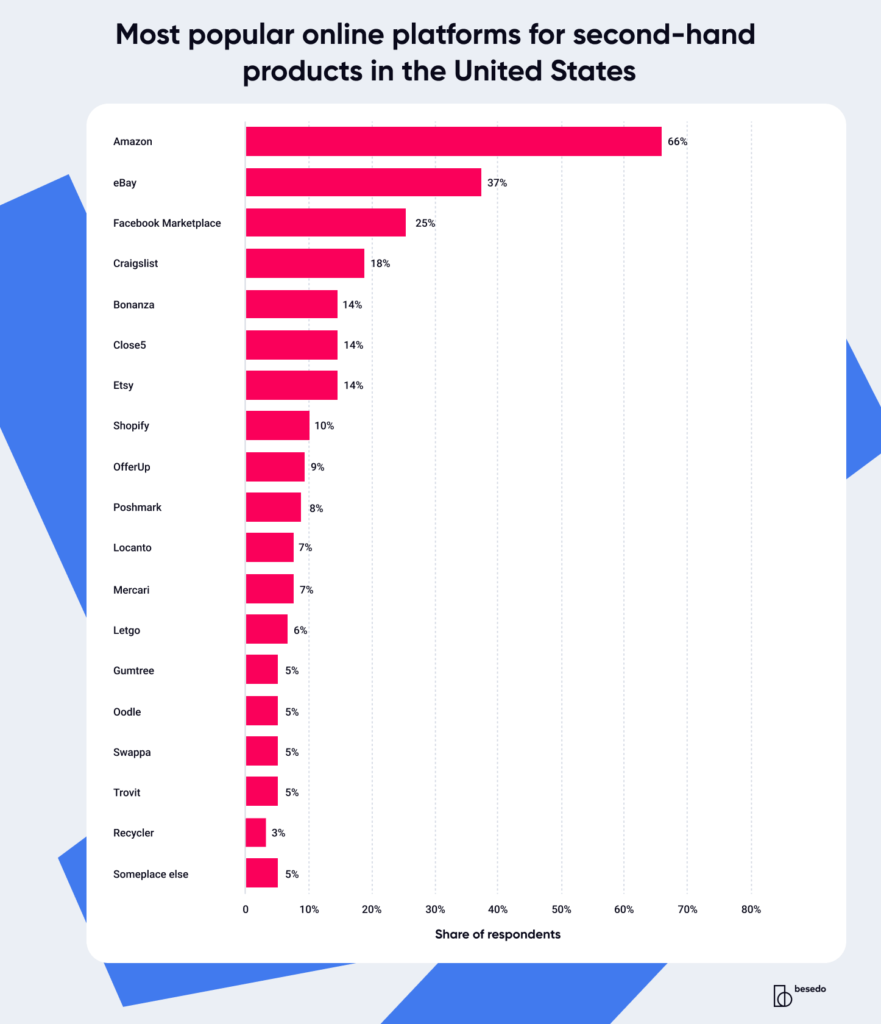Contents
The circular economy is in full swing, and for an excellent reason. With finite natural resources on the planet and the demand for resources exceeding what the earth can regenerate each year, we cannot continue with our current linear production path. The second-hand trend is here to stay.
The circular economy aims to transition into consuming less natural resources by reusing, upgrading, and recycling products. There are many benefits to this way of thinking, including reducing waste, extending the life of products, and saving resources. It’s also been shown to boost the economy by creating jobs in the recycling and reuse industry.

The resale of used items – an integral part of the circular economy – is booming as people grow more accustomed to buying second-hand. Resale has grown 21 times faster than the retail apparel market. It will become more significant than fast fashion by 2028, according to a thredUP and GlobalData report.
The second-hand market
Many companies are now looking to tap into the $24 billion second-hand market, and it’s easy to see why. Second-hand goods are often cheaper than their new counterparts, and there’s a growing consumer preference for sustainable and environmentally friendly products.
By bringing together buyers and sellers in one online space, online marketplaces help streamline the second-hand market. Thus making it more accessible to consumers. And with the added benefit of lower prices and greater sustainability, it’s easy to see why the second-hand trend is worth watching.
The environmental impact
According to a report by Schibstedt, aptly named The Second-Hand Effect, we note the following data points for instance:
290,992 tonnes of steel was potentially saved in 2021 by buying and selling used items. That’s the equivalent of:
- 11.5 million bicycles
- 323,330 cars
- 40 Eiffel Towers
By using the websites Blocket, Finn, and Tori, the Schibstedt users alone have potentially saved 8.2 billion plastic bags. Billion, with a b.
If there ever was time for the mind-blown emoji 🤯
Buying and selling second-hand items has been favored for numerous reasons. If people can find what they want for less money, they’re likely to purchase that item even if it’s been used. Additionally, the rising awareness surrounding the climate crisis and sustainability issues over the past few years has boosted the second-hand market.
Producing less waste and responsibly consuming resources is increasing in people’s agendas, increasing the popularity of online marketplaces.
Examples of second-hand online marketplaces
Several amazing second-hand marketplaces have popped up in recent years. These platforms provide a convenient way for people to buy and sell used items, often with an outstanding mobile experience, of which the importance cannot be overstated. Buy a new winter coat while waiting in line? Why yes, of course.
The biggest platforms are Amazon, eBay, and Facebook Marketplace. But there are also the likes of OfferUp, Mercari, Depop, and Poshmark — all mobile-friendly options that have recently gained popularity.

What do consumers buy and sell online?
The average American throws away about 81 pounds of textile waste each year. No surprise that clothing tops the list of pre-owned items American consumers buy and sell online. And nearly a third of all consumers (32%) are looking for pre-owned products when they shop online. 44% of consumers say they have bought or sold something pre-owned online over the last 12 months.
Top 10 pre-owned products consumers have bought or sold online:
- Clothing: 41%
- Books: 33%
- Electronics: 30%
- Furniture: 24%
- Jewelry: 23%
- Sporting goods: 22%
- Tools and home care items: 21%
- Exercise equipment: 20%
- Bikes: 16%
- Musical instruments: 14%
Increased risk for online marketplaces
This rise comes with increased risks for all online marketplaces, even the big ones, as more fraudsters will be attracted to your site.
Fraud can jeopardize user trust and ultimately scare off customers. Over the years, the sale of counterfeit goods has significantly increased in the luxury resale market. Therefore, it’s essential for online marketplaces to establish strong user trust, particularly in the trade of second-hand items.
In a two-sided marketplace, buyers must trust that sellers accurately describe the items on sale and that they will eventually receive their goods. In the same way, sellers must trust that buyers provide payment in good and due form.
You should protect your user trust and tackle these challenges head-on by implementing efficient and accurate content moderation processes.
Featuring poor or fraudulent content on your marketplace has a cost. Fraudulent activity will disastrously affect your reputation and the trust users have in your platform.
Second-hand is not a fad, and resale is becoming mainstream. As the demand for second-hand trade grows, marketplaces need to find new ways of dealing with fraud.
You can learn more about the different types of content moderation Besedo offers.
The future of online marketplaces
The second-hand trend is rising, with more and more people looking to buy and sell used items online. This trend is driven by several factors, including the growing popularity of online marketplaces, the increasing cost of living, and the desire for sustainable consumption.
There are many reasons why the second-hand trend is here to stay:
- Online marketplaces provide an easy way for buyers and sellers to connect.
- As the cost of living continues to rise, people are increasingly looking for ways to save money.
- There is a growing awareness of consumerism’s environmental impact, and many people are now seeking sustainable alternatives to new products.
As the second-hand trend grows, we expect to see more innovation in the online marketplace. For example, we may see the development of new platforms focusing specifically on second-hand goods or offering additional services such as repairs or alterations.
We may also see increased use of technologies such as blockchain to create a more secure and transparent marketplace for second-hand transactions.
Summary and key takeaway
The second-hand trend is quickly gaining traction and providing people with an environmentally friendly way to save money while finding unique items. With the rise of online marketplaces, it’s easier than ever for individuals to sell their pre-owned goods in a safe and secure environment. The future of this industry looks bright as more people embrace the concept of second-hand shopping – not only are they helping preserve our planet, but they’re also contributing to an economy that helps everyone win.




